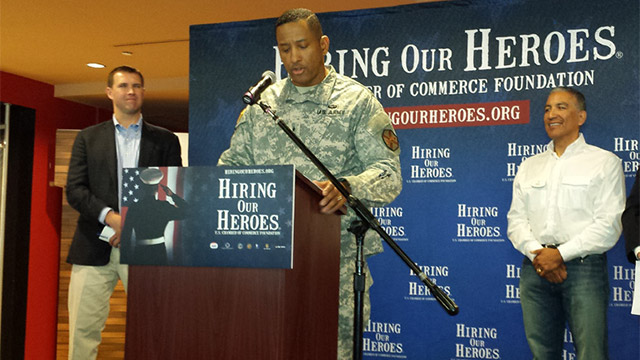Winning the war for talent
Innovative recruiting strategies for hiring top craft professionals
By Chris Towery
As construction companies begin to see contracts return, skilled workers are in short supply, and the industry is beginning to undergo what Steven Hankin of McKinsey & Company calls the “War for Talent.” This fight not only includes competition for top-level management and technical positions, but it is filtering down to the skilled crafts as well. Given this, contractors must enlist all of the resources at their disposal to secure the necessary manpower to be victorious in this struggle.
Recruiting revolution
Over the past few years, many of the larger construction firms have seen the labor shortage coming and have prepared for this challenge. Obviously, when it comes to finding skilled professionals, companies primarily rely on their human resources (HR) staff. However, due to changes in construction workforce demographics and culture, the traditional models and paradigms for HR are constantly evolving to fit with the emerging realities of today’s market.One of the most common developments in this evolution has been the addition of full-time recruiters to the HR team. “Due to changes in construction workforce demographics and culture, the traditional models and paradigms for HR are constantly evolving to fit with the
emerging realities of today’s market.” Gone are the days when a company could simply run a help-wanted ad in the local newspaper and expect to attract enough qualified candidates. More and more companies are now hiring recruiters to develop and implement specific plans and processes for finding, tracking, interviewing and hiring top talent. Although this is by no means a completely new development – and many large firms have had recruiters on staff for years – it is becoming much more common and is now being widely used for hiring craft professionals.
“Due to changes in construction workforce demographics and culture, the traditional models and paradigms for HR are constantly evolving to fit with the emerging realities of today’s market.”
Today, recruiters are on the frontlines in this effort, and they are using a wide range of strategies to meet their goals. Whatever methods they choose to employ, one thing is becoming clear: HR must take a much more proactive and long-term approach to recruiting if it wants to succeed. “HR is not just an occasional focus, but an ongoing part of the company strategy,” notes FMI’s Craft Labor Recruiting and Retention 2015 Survey Report. “Any company thinking it will wait until it absolutely needs to hire before starting a longterm recruiting plan will be caught napping and find it difficult to staff that next large project.”
The changing workforce
Another major change that has affected the industry is the evolving nature of the craft workforce itself. While it used to be common for large companies to have sizeable crews of craft professionals willing to travel across the country to live and work for extended periods of time, many of the industry’s craft professionals are less willing to travel extensively and are seeking a better work-life balance. According to the FMI report, this new outlook is due to a variety of factors, including a lack of desire to relocate, greater emphasis on family and more career options.Jim Hanna, executive HR director of construction, fabrication and craft services at Fluor, says that this situation has led his company to focus on developing a more regionalized workforce.
“Back in the 1970s and ‘80s, it was very common to have craft professionals follow their supervisors across the country to work,” said Hanna. “We used to have craft professionals from the Southeast go all the way to California, Oregon and Washington, but you just don’t see that anymore. It’s more of a regionalized workforce, so we have to supplement those who still do travel with others from the region where we’re working.”
Can you hear me now?
Along with the recession, the other big game changer on the cultural front has been the rapid development of digital technology. From the Internet and email to mobile phones and social media, practically every industry has had to integrate such technology. While construction firms have long used print media to advertise job openings, most of the print sources have been usurped by websites and social media. Although construction has arguably been somewhat slower to embrace these digital outlets than other industries, it is now clear that if you want to compete for skilled labor, you have no choice but to get onboard with the digital process.“Leveraging the way people communicate and interact with each other has been huge for recruiting,” said Tammy Mallaise, vice president of employment and labor relations at the Zachry Group. “When I began my role in HR seven years ago, the mentality still existed that a candidate had to walk into an employment office to get a job. That’s just not the case anymore. With digital technology, people can search for jobs 24/7, and if they have a cell phone, they don’t even need to get off the sofa. Zachry uses a web-based applicant tracking system, various social media outlets and a mobile-friendly website, as well as texting former employees about job opportunities.”
Hanna shared a recent experience that serves as a perfect example of how digital media has changed the face of construction recruiting. In 2013, Fluor secured a project in Winnemucca, Nevada, a small town located in a rural area. Fluor ran ads in a Salt Lake City newspaper and then rented out a hotel conference room to interview potential candidates. Over the course of two days, only 12 people showed up to interview. “That’s when I realized we were living in a different era in terms of how we’re going to recruit craft professionals,” said Hanna.
Following that experience, Fluor enhanced its website to include mobile functionality and also added a Spanish-language section to better accommodate the large base of Spanish-speaking craft professionals. The day the new site was launched, Fluor posted 15 positions online and more than 2,000 applicants viewed the postings. Hanna called the response tremendous and notes that Fluor has since embraced additional digital techniques to attract new job candidates and draw interest to the company as a whole.
“It’s absolutely vital to hire recruiters from diverse backgrounds in order to most effectively recruit others from the same backgrounds.”

Increasing diversity
In order to maximize diversity when recruiting, some contractors have begun hiring recruiters from a variety of different populations— veterans, women, minorities—based on the idea that they will be better able to relate to and recruit from the same backgrounds. “It’s absolutely vital to hire recruiters from diverse backgrounds in order to most effectively recruit others from the same backgrounds.”Most companies seek some range of diversity in their workforce, but this strategy takes the process to another level by specifically targeting certain populations to recruit from. Several companies have reported success using this tactic, so it pays to keep an open mind when considering it as a viable option.Mittie Cannon, director of workforce development at Robins & Morton, is one of those who have embraced this strategy, and as both a minority and woman herself, she’s convinced that it works.
“It’s absolutely vital to hire recruiters from diverse backgrounds to effectively attract the very best workers to our industry,” said Cannon. “For example, I tell people all the time that when it comes to recruiting women, especially African-American women, I can often connect in ways that other recruiters can’t.”

Veteran viewpoints
One population that has traditionally been an excellent fit for construction is military veterans. Because their time in the service has already instilled an appreciation for hard work, discipline, training, safety and leadership, veterans typically excel in construction and tend to stay in the industry a long time. Given this, it is clear that contractors would want to recruit more veterans.Like other diverse populations, many contractors have begun hiring recruiters and other HR staff with military experience so they can more effectively reach and relate to veterans. Darren Amick, currently the operations lead of craft workforce development at Bechtel, is a retired Army officer who spent 21 years in the U.S. military. He started at Bechtel in 2008 immediately after retiring from the Army, working in both security and management. “ A key benefit of having veterans recruiting veterans is that only someone with a military background can truly appreciate what it is like to transition out of the service.” When Bechtel enhanced its veteran recruiting, Amick was made the military program manager and tasked with developing a recruiting plan specifically targeting veterans. One of the key things he discovered was that no one could recruit a veteran as effectively as another veteran.
“If you want to have a successful military recruiting program, it is absolutely necessary to have veterans involved,” said Amick. “We hire veterans specifically to recruit other veterans, and right now, we have two military recruiters, both of whom are veterans themselves. One is based in Texas, and the other is in Maryland.”
Amick warns that contractors should not hire recruiters simply because they have been in the service. “Recruiters can’t just have knowledge about the military—they also have to know about the construction industry,” said Amick. “You have to know exactly what type of jobs you’re recruiting for, and you’ve got to have the trust of the people you’re recruiting for, so they’ll accept the folks you bring in.”
Another former military member who was hired to develop veteran recruiting strategies is Chris Newton. Newton spent 20 years in the Navy where he handled manpower training, recruiting and placement for craft services. From there, he was hired by ISC Constructors based in Baton Rouge, LA, as a recruiting specialist where he educated military members about careers in construction and worked with ISC’s recruiters to hire veterans. In December 2014, Newton was hired by Cajun Industries, also in Baton Rouge, to be the corporate workforce development coordinator.
According to Newton, a key benefit of having veterans recruiting veterans is that only someone with a military background can truly appreciate what it is like to transition out of the service. Having someone who understands exactly what this entails can be a very powerful recruiting tool. “It’s hard for me to see how someone without that experience could accurately explain the process and its challenges, because they don’t really know what it’s like to move from the rigid structure of military life back into the relative freedom of civilian life,” said Newton.

Cannon stresses that this approach makes sense, especially when a company is trying to recruit from a population that might not already be well represented within the company.
“The candidates see that there are people they can relate to and easily communicate with already working at the company,” said Cannon. “This naturally makes them more comfortable, and if they do hire on with us, I can serve as a role model—someone with a similar background who has been very successful within the company.”
It is not just diversity in terms of gender, skin color or ethnicity. Today, diversity reaches across all spectrums of identity — and fully embracing what this means allows businesses to really think outside the box in terms of HR strategy. Mallaise said that when hiring Zachry’s recruiters, she not only considers the typical issues of diversity, but she also looks for people who come from backgrounds outside of HR. As a former project manager and engineer with Zachry, she knows firsthand how her experience on the operations side enables her to be better at HR.
“When you’ve got so many different groups working together in one company, it’s really important to understand each other first before you can be effective,” said Mallaise. “This is where bringing folks who come from an operations or procurement background has really helped our HR team understand that there’s more to this business than just our little world.”
A key benefit of having veterans recruiting veterans is that only someone with a military background can truly appreciate what it is like to transition out of the service.”
Moreover, Mallaise explained how she sent some of her recruiting staff with backgrounds solely in HR to partner with and learn from Zachry’s operations’ staff. She noted that this made a huge impression on them, especially in terms of fully understanding the staffing needs and challenges other departments face.
“My HR professionals came back and told me that they had no idea about the issues these folks were dealing with,” said Mallaise. “They said, ‘Now I understand. Now I see why they were so frantic. Now I truly understand their point of view.’”

A proactive approach
While construction HR has progressed quite a bit over the years, some argue that construction is still lagging behind in this area. In many organizations, HR is deemed to be an essential and invaluable part of a company’s overall business plan. When HR is viewed in this way, it opens the door for recruiting to become a highly effective tool for advancing the company’s goals and objectives.“Viewing HR as a business partner can help drive the company’s overall strategy,” said Mallaise. “It’s about HR understanding the direction the company is headed and then helping reach those goals. It’s much more of a proactive role.”
As with many other high-level business strategies, such an approach sounds perfectly reasonable in theory, but the real challenge is incorporating such an objective within HR’s day-to-day processes. That said, Mallaise’s background in engineering and operations has enabled her to take a very practical approach to the issue.
“Implementing this entails working with your project and operations teams, trying to understand what keeps them up at night and then getting out in front of that,” said Mallaise. “HR must have people who understand exactly what it means to plan; people who understand how to forecast staffing needs; people who know how to read histogram curves, cost reports, schedules and other analytical tools.”
Mallaise believes that HR will continue to become a much more integral part of construction’s overriding business plans and goals. “On our construction projects, we consider our equipment needs, we carefully think through our procurement needs—we plan around everything,” said Mallaise. “Our staffing needs aren’t any different. That level of planning requires people who know and understand the business.”
As the industry becomes more embroiled in a war over skilled craft professionals, many construction firms are likely to find themselves adopting these tactics sooner rather than later. With constant changes inherent in today’s labor market, such strategies may ultimately prove to be the deciding factor in a company’s success or failure.
About the Author
This article was originally published in the Spring/Summer 2015 edition of NCCER’s The Cornerstone magazine (http://www.nccercornerstone.org/publications/publications-archive). This content has been republished with the permission of NCCER and the publisher.



















